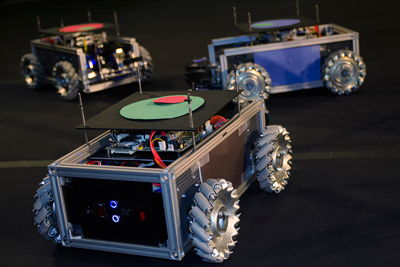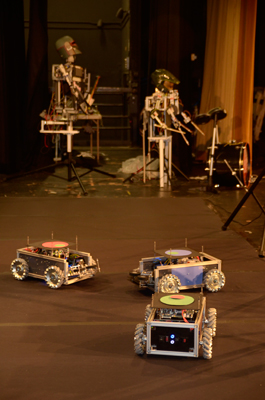Students share 'modbot' design for future Cornell Cup competitors
By Anne Ju


At first glance, two sets of Cornell-developed robots seem pretty unrelated: upright humanoids showing prowess at the Nintendo Xbox game Rock Band, and four-wheeled omnidirectional rovers scooting across a stage.
But then came the big reveal during the Cornell Cup USA Presented by Intel: The two robotic systems are fundamentally identical, based on a streamlined modular design called the modbot that the students have been working on for the past year. The modbot, complete with detailed documentation on how to build it, will be freely available for future Cornell Cup competitors.
About 30 Cornell engineering students played host at the inaugural Cornell Cup, a professional engineering design competition, held May 4-5 at the Disney Contemporary Resort in Lake Buena Vista, Fla., sponsored by Intel and Tektronix, MathWorks and Maxon Precision Motors.
Twenty-one university engineering teams descended on Disney World to vie for cash prizes awarded to the best examples of "embedded systems" employing the Intel Atom processor. Entries included a solar-powered drone from University of California-Berkeley and an obstacle-detecting belt for the blind from the University of Pennsylvania.
The Cornell students, whose hosting duties ranged from ferrying students between judges to staffing booths, did not compete. But they did get to exhibit their own embedded design with the modbots and Rock Band robots, which brought together students from mechanical, electrical and systems engineering, and computer science.
The modbot can now be a starting point for future competitors who are seeking a robotics platform. They won't have to deal with common technical hurdles like battery packs, power boards, safety circuits and wireless communications, explained David Schneider, lecturer in systems engineering and adviser to the Cornell Cup team.
"Normally when you build a robot, you build it for something very, very specific," Schneider said during the modbot demo. "You saw the Rock Band robot yesterday -- those can [play Rock Band] and nothing else. But [the modbot] has actually been designed to be taken apart and added to. It's a robust mechanical, electrical and computer science test bed."
Throughout the event, Cornell students ran demos of their robots, which included Rock Band bots playing at 99 percent accuracy (the robots were just jamming; the game was actually being played by a computer platform powered by the Intel chip), and the modbots, equipped with multidirectional Mecanum wheels, zooming across a stage without help from humans.
The modbots look like little cars with their mechanical guts showing. The students demonstrated the ability of the robots to move autonomously, thanks to an overhead four-camera setup and color-coded "hats" that served as the robots' vision system.
"One of the biggest problems that people try to solve when they create robots is having the robot know where it is, and how to make it know where it's going," said Bianca Cha-Camp, M.Eng. '12. "Our way of telling the robot where it is, is through an outside sensor system, which is the cameras."
Building the modbots, said Michael Grisanti '14, was a long process with a lot of trial and error, but the idea was to save others from that process.
"It's so they can get right to the meat of their project and what they want to do and to not worry about battery management or motor controls -- things like that," Grisanti said. "I hope people are excited about getting a hold of some of these systems and using them in different ways."
Media Contact
Get Cornell news delivered right to your inbox.
Subscribe